SavannaScapes
SavannaScapes
2-5 players • 30 min • 8 & up
Focus: Ecosystems
Couldn't load pickup availability
Explore the Serengeti-Mara Ecosystem and its incredible wildlife! Strategically place species tiles to create perfect habitats, earn points by meeting animal needs and event tiles. Master the ecosystem to score the most points!
Skills: Ecosystems, Strategy
Game Includes
Game Includes
- 80 Species Tiles
- 8 Event Tiles
- 5 Start Tiles
- 5 Animal-Print Pawns
- 70 Point Tokens with tray
- 1 Round Tracker with Pawn
- 1 Tile Bag
- 1 Serengeti-Mara Fun Facts Booklet
- 1 Rules Booklet
Share
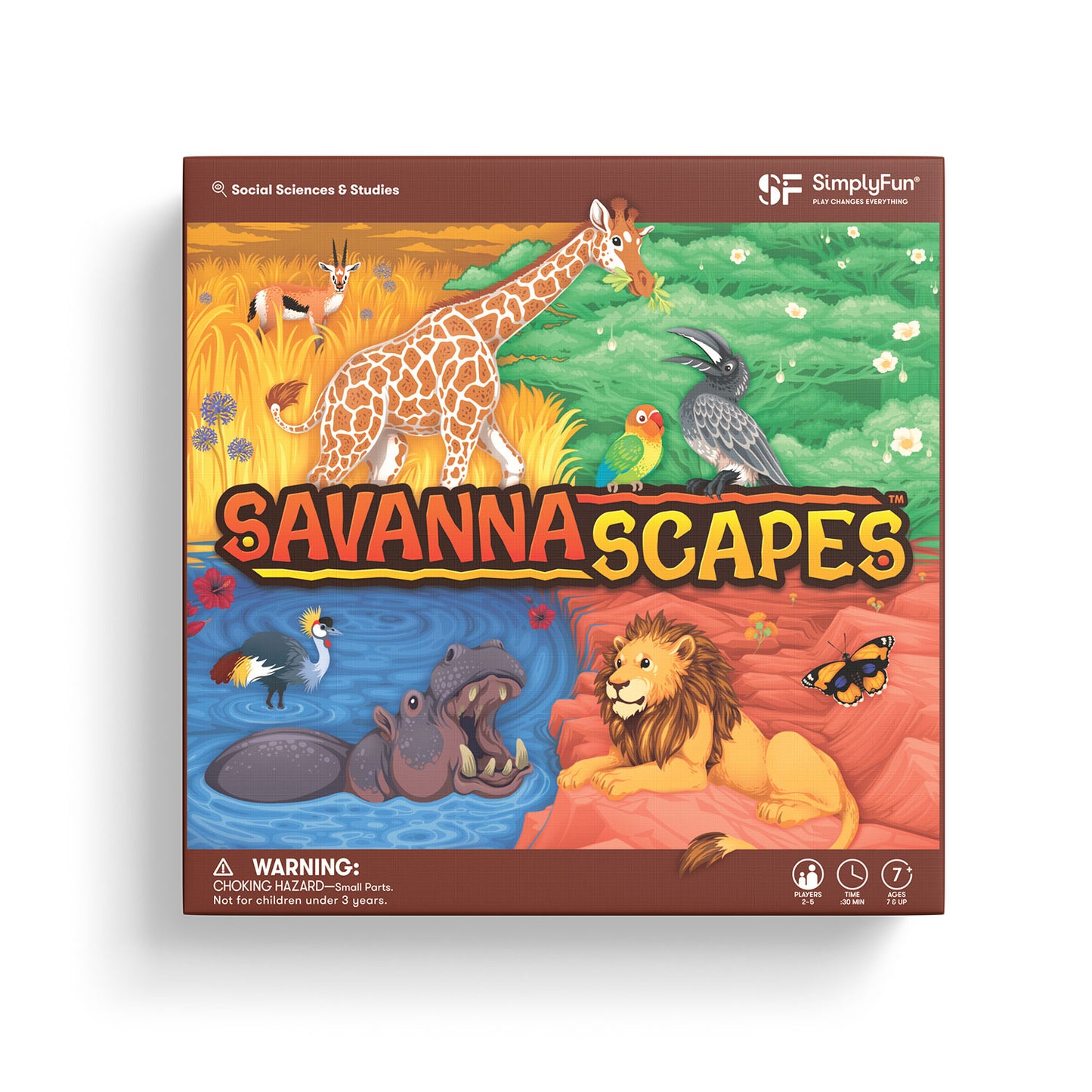
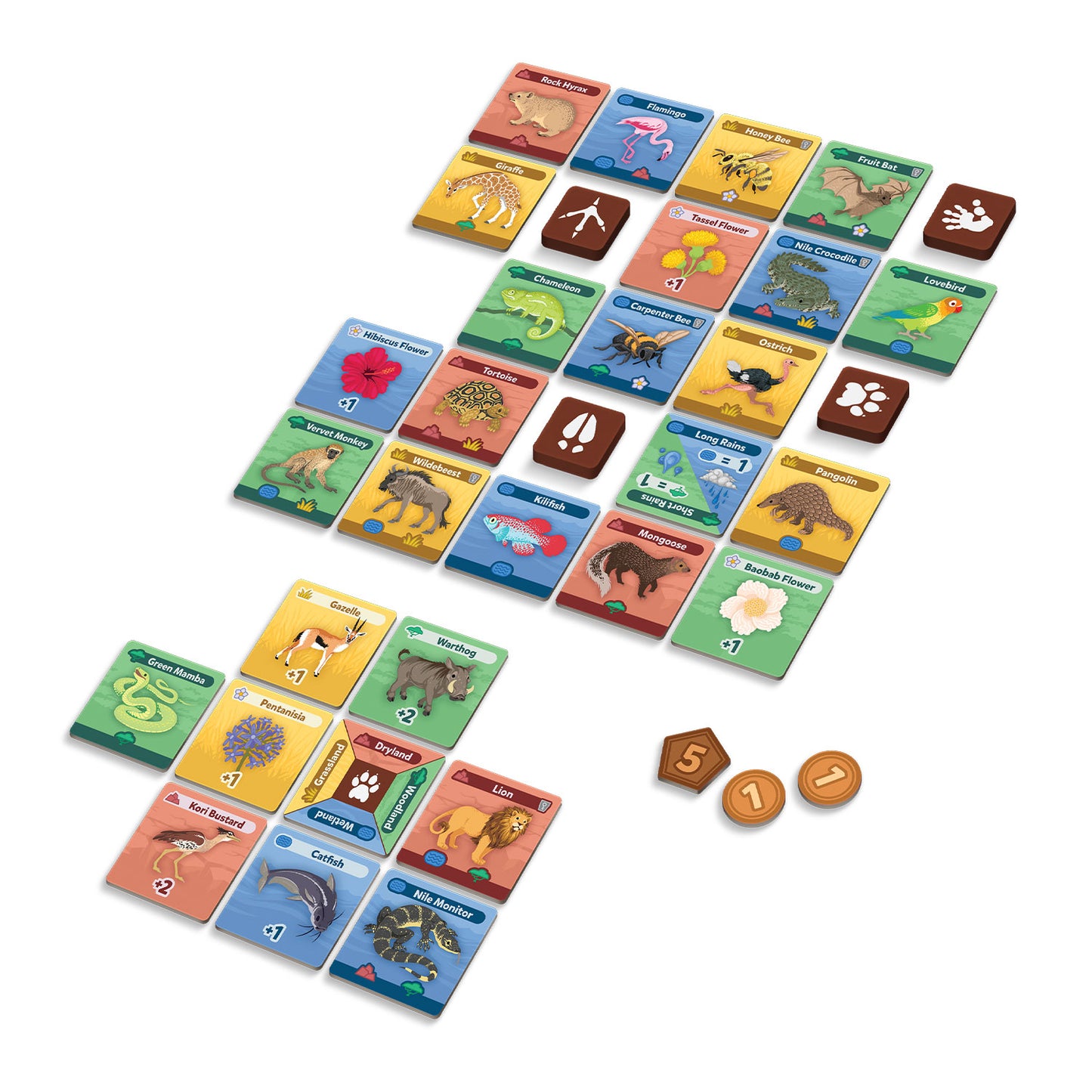
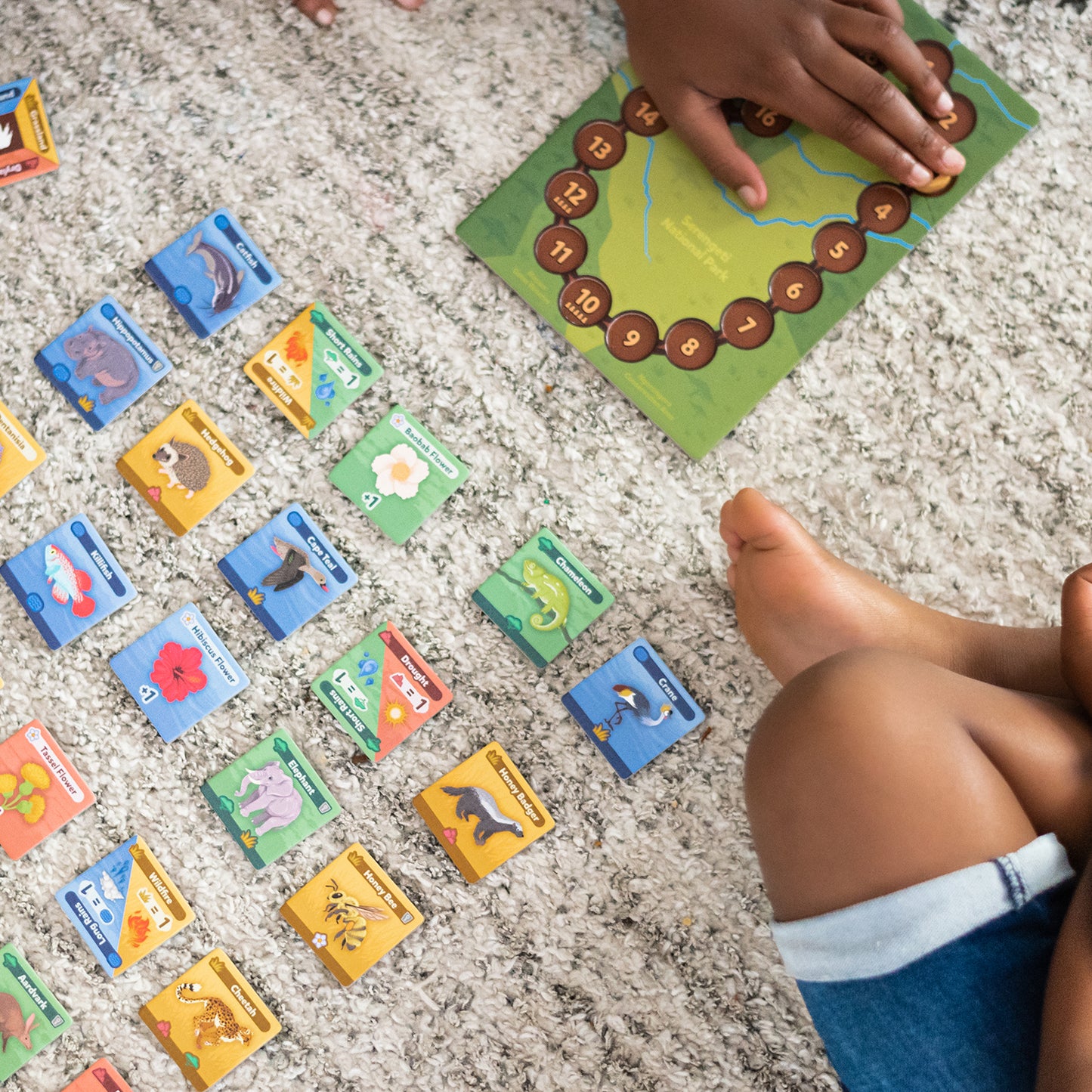
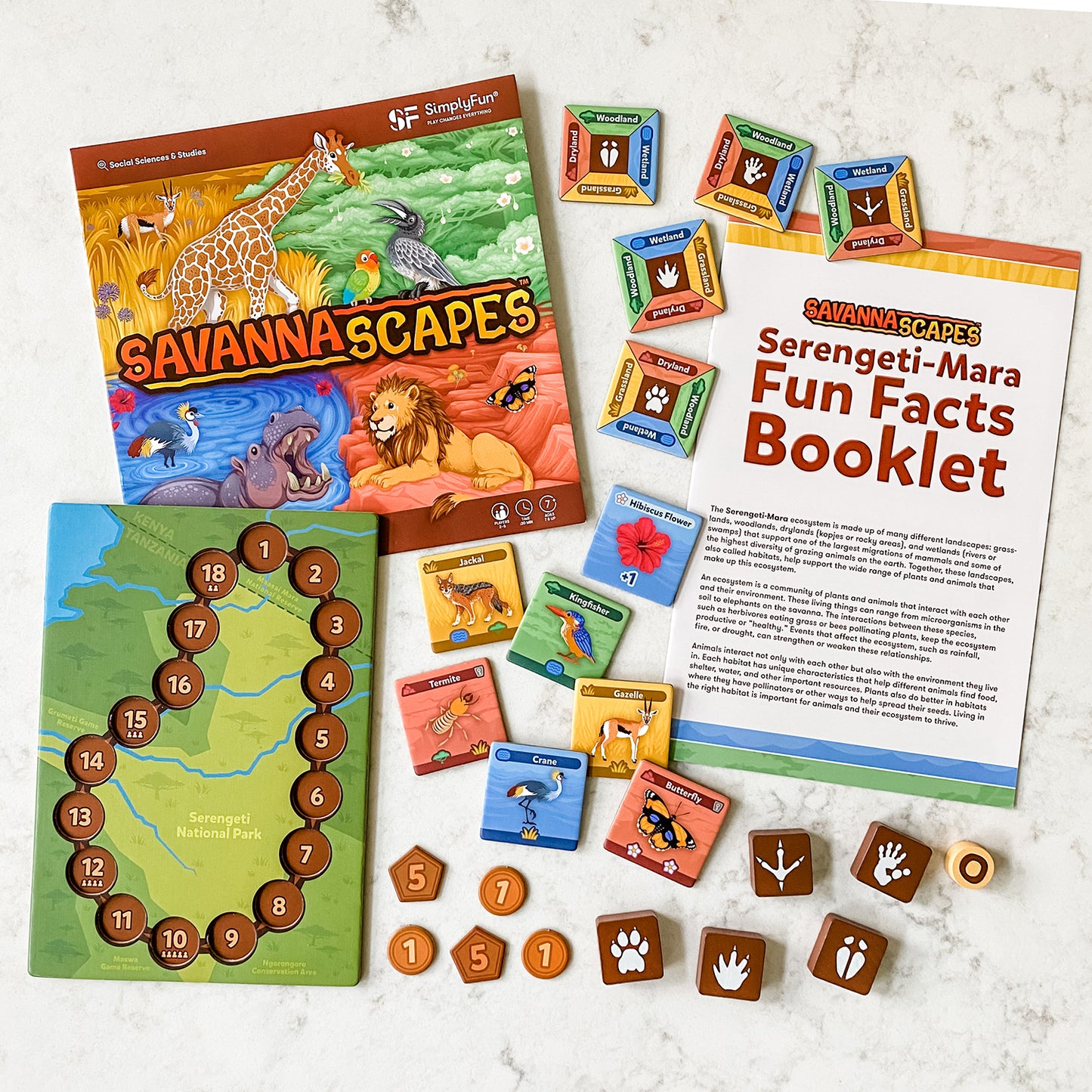

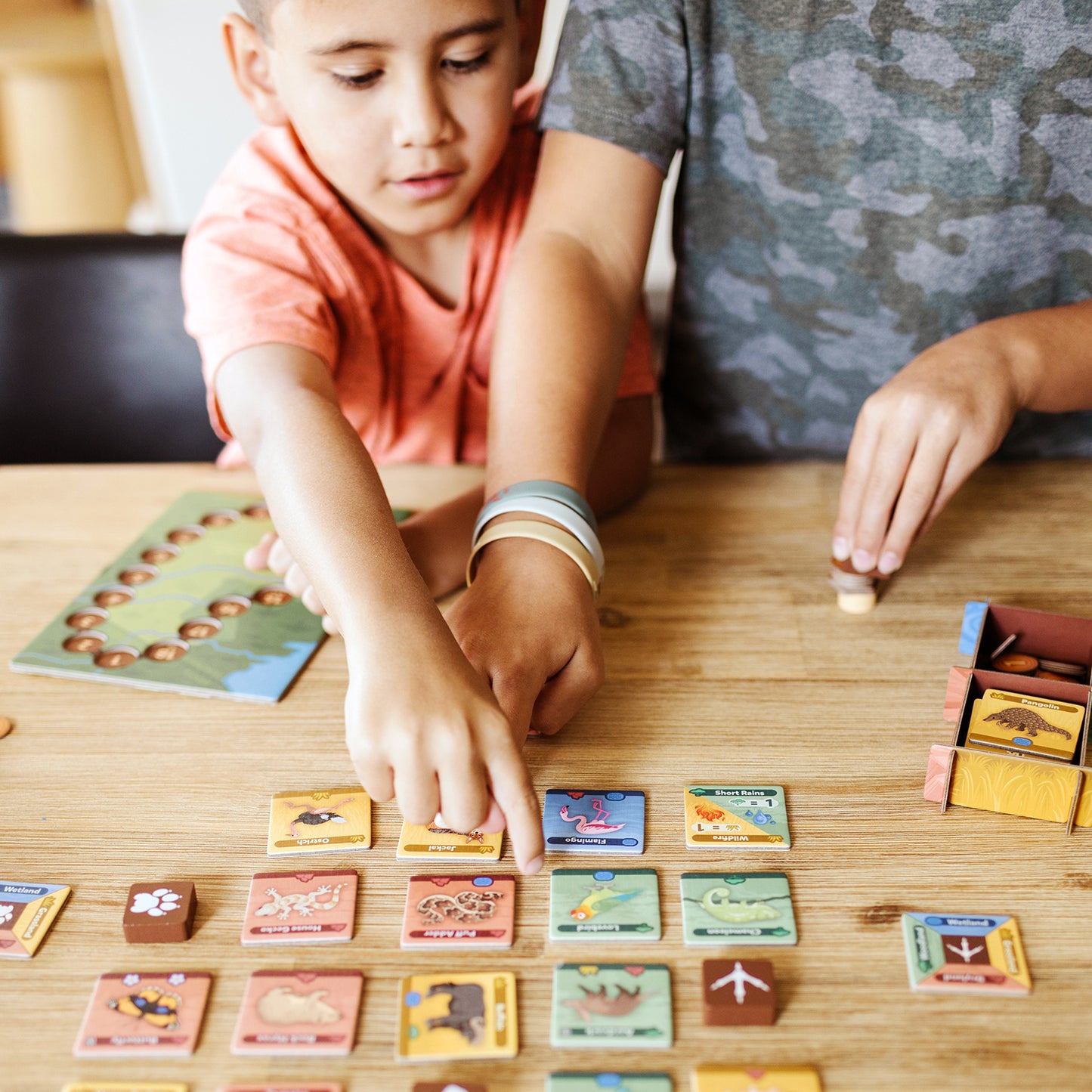
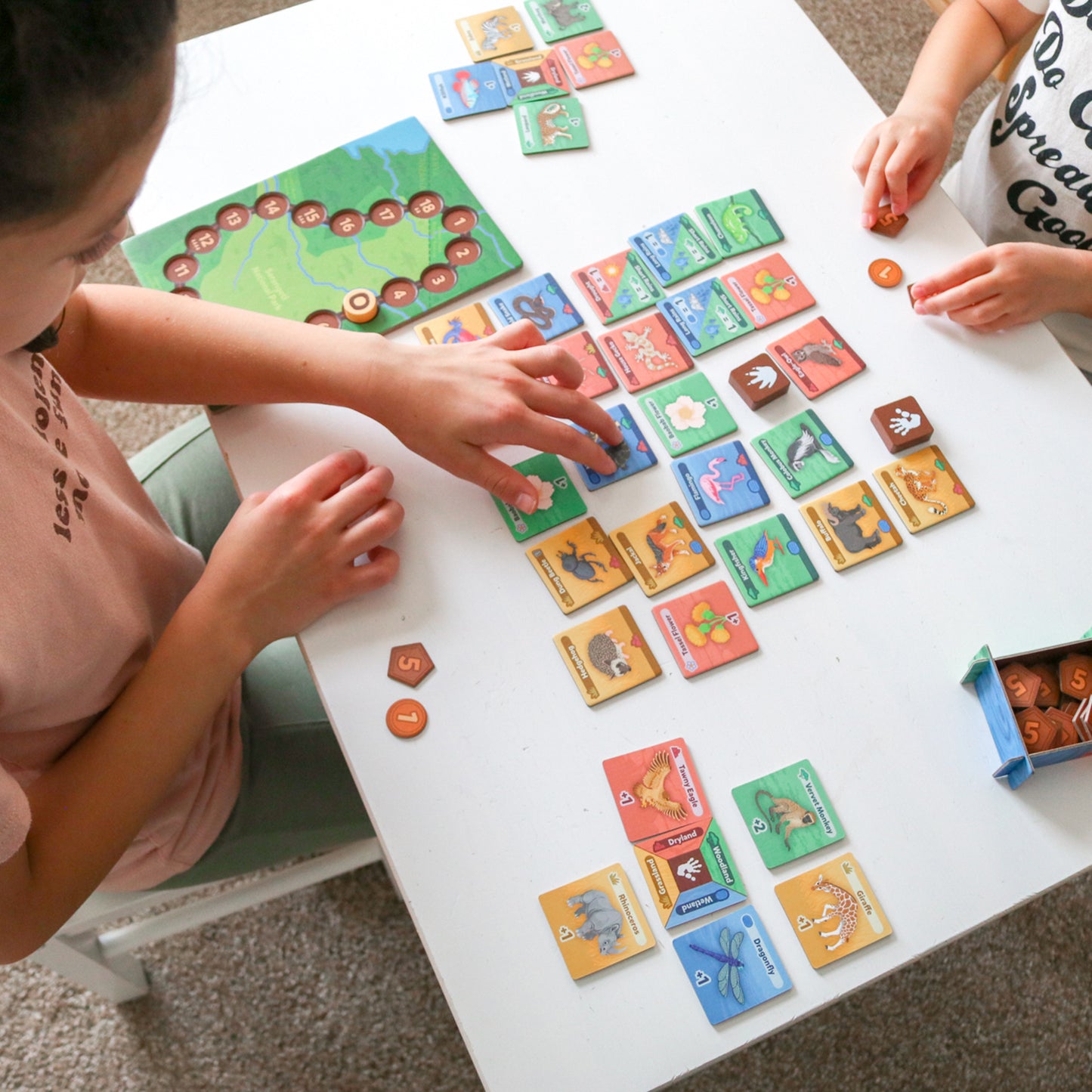
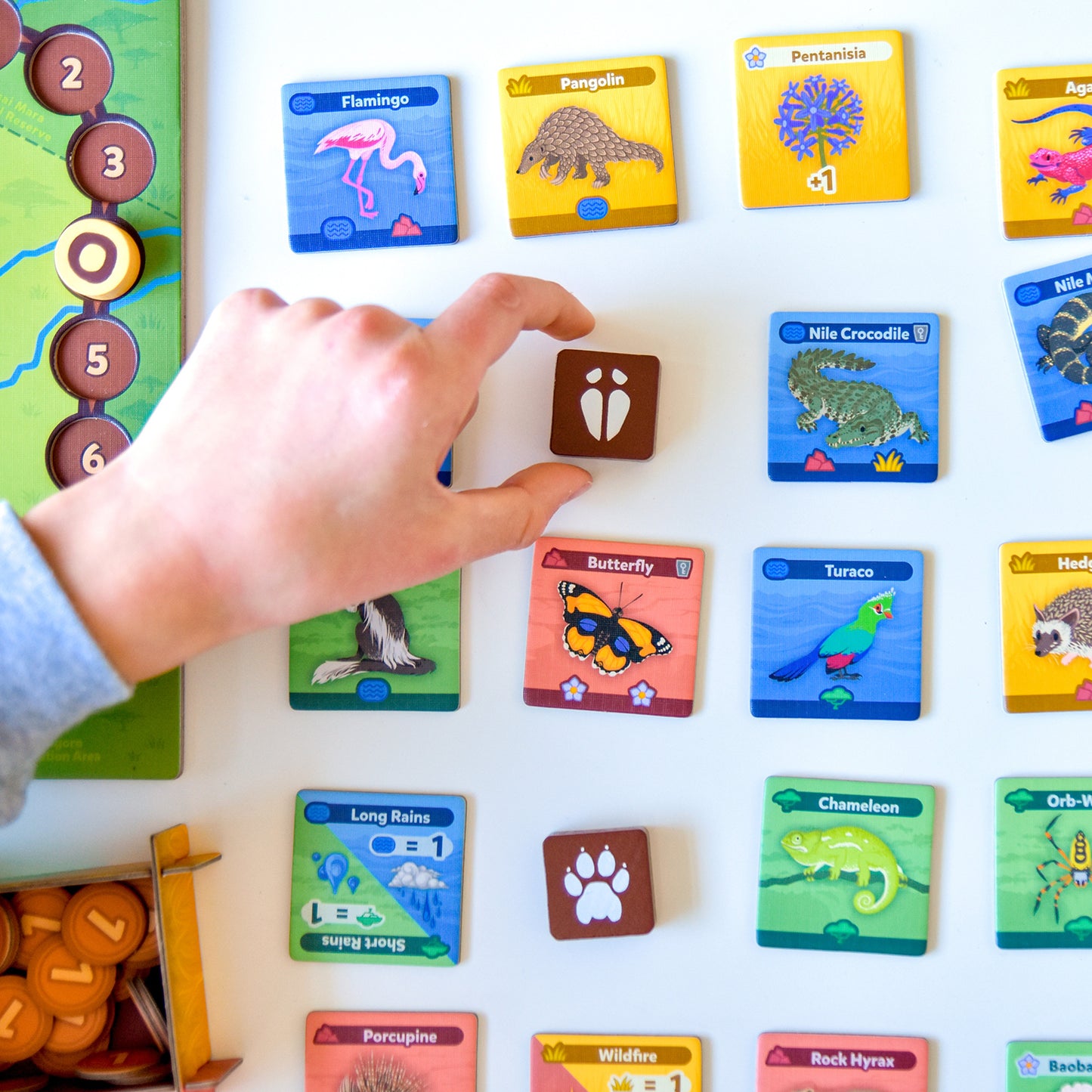
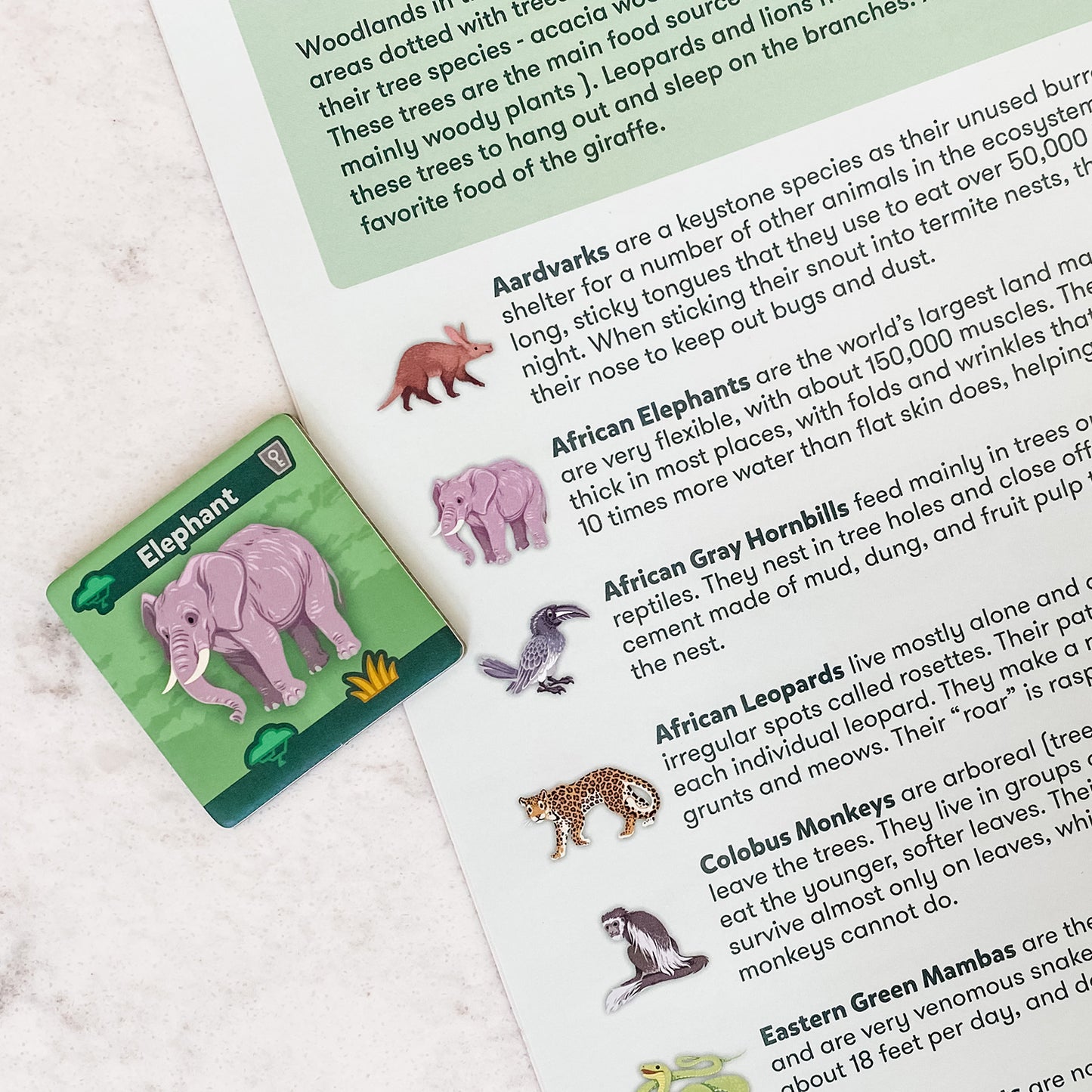








More Information
More Information
Collapsible content
A game where players create ecosystems by matching animal tiles with their habitats.
You can play SavannaScapes with 2 - 5 players, ages 7 and up!
SavannaScapes is good for developing knowledge of Ecosystems as players learn about the different habitats of the Serengeti-Mara region and how the animals, plants and environmental events interact with each other.
SavannaScapes also helps players learn Strategy Skills as they move around the play area choosing animal, plant, or event tiles to score points and build their ecosystems.
• Place all the animal, flower, and event tiles into the tile bag and shake to mix them up.
• Randomly pull tiles from the tile bag and place them in a 5 x 5 grid pattern to create the play area. Place animal tiles number side is down, and the icon side is up. Other tiles will be the same on both sides
• To decide who goes first, all players draw a tile from the bag. The first player is decided by which tile name comes first alphabetically. Turn order continues clockwise from the first player.
• Each player chooses an animal-print pawn and a matching start tile. Placing the start tile in front of themselves and then placing the pawn in one of the indicated spaces in the play area.
• Put all the point tokens, sorted by value into the tray, and place it to the side where everyone can reach.
• Place the round tracker where everyone can see it and place the tracking pawn on round 1.
• Based on the number of players, determine how many rounds you would like to play.
Players move around the play area, choosing animal tiles and placing those tiles next to others to provide them with their needed habitats, creating an ecosystem. Point tokens are earned each time a player can meet the needs of their animals. The player with the most points when all rounds are completed wins.
Let’s first take a look at the tiles in this game.
Animal Tiles:
The icons at the bottom of the animal tiles show which habitats the animal needs to score points. There are four habitats – Grasslands, Drylands, Woodlands and Wetlands. The icon next to the animal’s name and the background of the tile show which habitat type they provide to any adjacent tiles.
By placing an animal next to another tile, they share habitats. If one tile’s habitat matches the needs of its neighbor, it helps complete the tile. Every animal has one or two needs, so you may be able to meet the needs of a tile as soon as you place it.
Once an animal tile’s needs are fully met, flip the tile over to reveal the number of points earned and collect that number of point tokens. You may be able to flip over more than one tile on a turn.
Tiles you flip stay that way for the rest of the game and flipped tiles can still provide habitats to tiles next to them.
Some tiles will also include a keystone species icon. Animals with a keystone icon to the right of their name are worth one additional point. The extra point is included on the backside of the tile. Other than the point difference, these are played the same as any other animal tile.
Flower Tiles:
In addition to animal tiles, there are also flower tiles. These tiles are the same on both sides and don’t need to be flipped over during play. The background color of the flower tiles represented its habitat type and can provide that habitat to any animal it is next to.
Flower tiles are needed for all pollinators.
When a flower tile is chosen from the play area, that player immediately collects a one-point token.
A flower tile can be placed in any location in the player’s ecosystem.
Pollinators
The honey bee, carpenter bee, fruit bat and butterfly are pollinators and have the flower icon included on their tile. Pollinators need to be next to a flower tile in order to score. Flower tiles from any habitat can meet this requirement.
Now that you understand a little bit about the tiles, here is how to play.
Each player's ecosystem begins with their start tile. The start tile can be rotated any way you like but cannot be changed after the game starts.
The four sides of the start tile each represent one of the four habitat types found in SavannaScapes.
Players should pay attention to a tile’s habitat type to earn points. There are three ways to earn points in the game.
1) By placing flower tiles collected from the play area into your ecosystem.
2) By placing animal tiles collected from the play area into your ecosystem next to their needed habitat type.
3) By playing event tiles that give players additional points for having the chosen habitat.
Each turn consists of three steps. On your turn:
1) Collect a tile from the play area.
Look at the available tiles in the same row or column as your animal-print pawn. Based on the potential point value or habitat needs of the animals in your ecosystem, choose one of the tiles and collect it. Then, move your pawn into the space that the tile was removed from.
2) Add the tile selected to your ecosystem and collect any possible points earned.
The goal when placing a tile is to provide animal tiles with their needed habitats. You may place the tile you have selected next to any tile within your ecosystem. The icons at the bottom of each tile show the habitats they require, so try to match the icons on your tile to the backgrounds shown on adjacent tiles. After placing the tile, determine if you have earned any points from that tile or from another tile previously placed in your ecosystem, and collect the appropriate point tokens.
3) Place a new tile in the play area.
Draw a tile from the tile bag and place it in the empty space where you moved your pawn from.
It is now the next player’s turn. Play continues clockwise.
Event Tiles
A player may choose to pick up an event tile instead of an animal or flower tile. Each event tile has two possible events to choose from.
Event tiles are different because they affect all players when played.
There are many events that are important to the health of the Serengeti-Mara ecosystem including:
Wildfires, Drought, Short and Long Rains.
When these events occur, all players gain a one-point token for each of the specific benefited habitats they have in their ecosystem.
Wildfire – Events benefit the Grasslands.
Drought – Events benefit the Drylands.
Short Rain – Events benefit the Woodlands.
Long Rain – Events benefit the Wetlands.
When an event tile is chosen from the play area, that player decides which of the two possible events they wish to activate. Both events can’t be activated, so the player should choose the event that will benefit their ecosystems the most compared to everyone else.
The player announces the chosen event and identifies the affected habitat. Then, each player counts the total number of those tiles in their ecosystem and collects that number of point tokens. The player that chose the event includes the event tile they just played in their total.
Every tile you have added to your ecosystem can be counted towards your score during an event.
After the event has taken place and everyone has collected their points, the player that chose the event now places that tile into their ecosystem. These tiles can be placed next to other tiles just like animal or flower tiles and can serve as that habitat to an animal tile next to it.
While each event tile has two different habitat types, only the habitat that is directly touching the tile next to it qualifies. Depending on placement, this tile can help multiple animal tiles.
On future turns when event tiles are played, these tiles will continue to represent two habitats and will continue to earn points.
Once placed you can’t move or rotate the event tile, so place them carefully.
Tracking Rounds
Use the tracker and pawn to keep track of the number of rounds you’re playing.
Move the tracking pawn along the track each time a new round begins.
The number of players determines the number of rounds you’ll play.
After completing the indicated number of rounds, the game ends and the point tokens are added up. The player with the most points wins.
If there is a tie, the tied player with the most Keystone tiles wins.
If there is still a tie, players can share their victory.
Explore the Serengeti-Mara region as you learn about animals and their habitats with SavannaScapes!


Core Standard*: Social Sciences and Studies
Science
- Ecosystems
- Changes in Ecosystems Grade Levels 2nd, 3rd
Reading
- Reading: Informational Text
- Range of Reading and Level of Text Complexity Grade Levels 2nd, 3rd


Explore
What Does Child Do To Use Skill In The Game?
Players need to look closely at the tiles in the play area and the ecosystems of all players in order to assess options for selecting and playing a tile on their turn.
How Parents Can Assist Learning
If needed, parents can remind children to examine the icons on each tile carefully to help the children make better choices of tiles to select. Also, to spark their curiosity, encourage children to read a fact from the Fun Facts Booklets about the animal on the tile they collect from the play area.
Learning Implications and Educator Support
SavannaScapes is a good game for developing strategic thinking, spatial reasoning and situational analysis. Remind children to look at the play area and other players' habitats closely on their turn. This will discourage impulsive actions.
Also, to spark their curiosity, encourage children to read a fact from the Fun Facts Booklets about the animal on the tile they collect from the play area.
Determine
What Does Child Do To Use Skill In The Game?
Players decide which tile to pick that will be most helpful to their habitat. They may also decide to select an event tile based on their analysis of the benefits to them versus the other players.
How Parents Can Assist Learning
Because SavannaScapes involves so much decision making, including predicting what others will do, it may help to encourage children to "Wait. Look. Think." This will help them spend time enough time considering options and implications of different possible decisions.
This will also help with impulsivity and planning. Using such verbal cues can give children a model for approaching future play as well as complex life choices.
Learning Implications and Educator Support
SavannaScapes is good for developing decision-making skills such as risk-reward analysis and strategic planning. To further their learning, ask children to explain their decision to other players. This can help all players change perspectives, build empathy and learn new ways of problem-solving.
Compare
What Does Child Do To Use Skill In The Game?
SavannaScapes involves a lot of comparison as players evaluate tile types, habitats and tile symbols in order to ultimate decide what tile to pick and where to play on their habitat.
How Parents Can Assist Learning
Because comparing is directly associated with 'determining' when playing SavannaScapes, parents can assist by asking questions such as, "Would selecting a species or event tile be a better choice?", or "Can you play a tile now that will allow you to have better scoring options next turn?"
Learning Implications and Educator Support
Comparing in SavannaScapes helps children learn situational analysis because they need to consider and compare the consequences of selecting and playing a species or element tile.
To help children, have them describe aloud the scoring options based on at least 2 tiles they can pick on their turn. Ask specific questions such as, "How would playing an element tile affect the scores of all players?" Verbalizing is a good technique for strengthening the child's analytical abilities and problem-solving.
Predict
What Does Child Do To Use Skill In The Game?
As the game proceeds, players will be able to more accurately predict tiles other players may try to collect in order to block you or collect tiles that will help them score more points.
How Parents Can Assist Learning
Parents may need to remind children to look at the habitats of other players. This can help them consider what other players are trying to accomplish, as well as to assess which tile they can select that will help them the most by scoring points or preventing others from scoring.
Learning Implications and Educator Support
Playing SavannaScapes helps children develop spatial reasoning skills, situational analysis, risk assessment and perspective changing, all skills that can be used to make more accurate predictions of opponents' moves. Additionally, making predictions requires analysis, observation, empathy and interpretation.
Educators can encourage children to discuss their options and to declare why they are selecting to play a certain tile on their turn.
Plan
What Does Child Do To Use Skill In The Game?
Players will develop plans for building their habitats. However, because the play area changes every time another player picks and places a tile, it is hard to plan for which tiles a player can select on subsequent turns.
How Parents Can Assist Learning
Parents may need to remind children to remain flexible with their plans for their habitats. Like chess, the play area changes as players make their moves. Therefore, children will need to have a general plan for their habitats, but then adapt that plan as play continues.
Learning Implications and Educator Support
Planning is an important skill for developing strategic thinking and reaching a goal. Planning is also essential to developing and executing strategies, as well as managing life's activities from going to school to cleaning up your room.
In SavannaScapes, the planning includes selecting and playing tiles to build the highest scoring habitats. Additionally, because other players are also selecting tiles from the same play area, SavannaScapes helps children develop flexible thinking as they adapt to the choices made by others.
Educators can encourage children to take their time to think through all the options prior to deciding what moves to make.
Practice
What Does Child Do To Use Skill In The Game?
Because SavannaScapes contains many implicit levels of mastery, players will improve their strategic thinking the more they play the game.
How Parents Can Assist Learning
SavannaScapes is good for developing decision-making skills such as risk-reward analysis and strategic planning. To further their learning, ask children to explain their decision to other players or review the game together after it is over. This can help all players change perspectives, build empathy and learn what works best throughout the game.
Learning Implications and Educator Support
SavannaScapes is good for developing decision-making skills such as risk-reward analysis and strategic planning. To further their learning, ask children to explain their decision to other players or review the game together after it is over. This can help all players change perspectives, build empathy and learn what works best throughout the game.
Solve
What Does Child Do To Use Skill In The Game?
As the game proceeds, players examine what others are doing in order to adapt their strategies to gain more points or prevent other players from scoring points.
How Parents Can Assist Learning
If you notice that a child is not selecting tiles that optimize their score or block other players who are leading, ask the child to explain their thinking and discuss what they might do differently next time.
Learning Implications and Educator Support
SavannaScapes involves uses of visual spatial reasoning, risk-reward analysis and if/then problem solving. After children have mastered the rules, functions and relationships of the tiles, they learn new information constantly during game play. This information directly effects how children strategize an approach for collecting and playing tiles, and ultimately solve the game.
*Data compiled from CCSSI ELA Standards, WA Science Standards, and Washington Social Studies Standards


Cognitive
Suggestions for How to Modify Play Experience
Eliminate all of the two- and three- point tiles, using only the 1-point tiles. This will mean the player only has to match one symbol at a time.
Sensorimotor
Suggestions for How to Modify Play Experience
If the child has extreme fine motor challenges, placement of tiles may be too difficult. Pair the child with a partner which will encourage discussion of which tile to take and then the partner can place the tile.
Social Emotional/Behavioral
Suggestions for How to Modify Play Experience
Players who are not strong strategizers and have low frustration tolerance may be aggravated by not being able to score many points. Playing with a partner will enable discussion and modeling of how to think about strategy. The partner can also model how to handle another player's making a better move.
*Data compiled from CCSSI ELA Standards, WA Science Standards, and Washington Social Studies Standards


Autism Strengths & Interests
Short Summary of Strengths & Interests
- Strategy
- Decision Making
- Animals and Habitats
Is good at matching visual items
Is This Game Appropriate? Yes
Description
SavannaScapes requires identifying small symbols on tiles and matching these to other tiles to build an ecosystem.
Has a good memory for sensory details, including visual, touch, taste and smell
This game is not appropriate
Has a good memory for words, phrases and dialouge
This game is not appropriate
Has a good memory for pictures, numbers and patterns
Is This Game Appropriate? Yes
Description
Memory for pictures is not needed, but ability to identify potential matches in future plays will help players strategize.
Likes to put things in order or a sequence
Is This Game Appropriate? Yes
Description
SavannaScapes requires buiding a habitat by combining like elements on animal tiles. There is a logical order to the sequencing of tiles.
Learns through visualizing or "replaying" actions in their mind
Is This Game Appropriate? Yes
Description
Ability to visualize future plays will enable the player to think ahead. For example, buiilding a habitat with many woodland tiles, will enable the player to gain many points by planning to position their animal print pawn so they can acquire a "short rain" event tile. This requires the player to viusalize several moves in a sequence.
Likes activities with rules, such as math and phonics
Is This Game Appropriate? Yes
Description
Spatial reasoning is involved, as players must play within specific rows and columns in relation to their animal print pawn.
Is very concrete and literal
Is This Game Appropriate? Yes
Description
The matching of habitat symbols is very concrete. Planning a sequence of moves is more abstract, but players can play at a more concrete move-by-move level as well.
Learns in small "chunks" (for example, phone numbers are 3 chunks of number xxx-xxx-xxxx that are combined together)
This game is not appropriate
Is good at nonverbal reasoning and logic
Is This Game Appropriate? Yes
Description
Players need to play within the column or row where their animal print pawn is placed. They need to plan how to get to the tiles they want to add to their habitat or to an event tile they want to use. They also need to anticipate how other players may move to potentially block them.
Likes spatial problem solving
Is This Game Appropriate? Yes
Description
Players need to play within the column or row where their animal print pawn is placed. They need to plan how to get to the tiles they want to add to their habitat or to an event tile they want to use. They also need to anticipate how other players may move to potentially block them.
Can read well with good vocabulary, though may not fully comprehend content
Is This Game Appropriate? Yes
Description
Reading the Sarengeti-Mara Fun Facts Booklet will enrich the game play by providing knowledge to accompany the animal tiles and habitat symbols.
Likes to use and has good fine motor skill
Is This Game Appropriate? Yes
Description
Players need to arrange tiles next to each other in such a way that all sides align.
Likes established routines or set ways of doing things
This game is not appropriate
Likes manipulating, constructing or building things
Is This Game Appropriate? Yes
Description
Likes to use and has good musical abilities
This game is not appropriate
Likes to use and has good drawing skills
This game is not appropriate
Autism Special Considerations
Appears to ignore other's communication and/or has difficulty giving eye contact to a communication partner
Is This Game Appropriate for Child with Characteristic? Yes
Can Child with Characteristic Play Game w/o Modification? Yes
Strategies for Developing Compensatory Skills:
Players do not have to give eye contact or communicate with other players.
Has difficulty understanding complex verbal directions
Is This Game Appropriate for Child with Characteristic? No
Can Child with Characteristic Play Game w/o Modification? No
Strategies for Developing Compensatory Skills:
The directions for SavannaScapes are complicated. Unless the player has a partner in play to guide them, the game may be too difficult to understand.
Uses vocabulary inaccurately or demonstrates echolalia (repeating another's speech)
Is This Game Appropriate for Child with Characteristic? Yes
Can Child with Characteristic Play Game w/o Modification? Yes
Strategies for Developing Compensatory Skills:
Unless the echolalia is extensive and totally off topic, it should not interfere with other players moves. If it keeps the child from attending to the game, then SavannaScapes will not be an appropriate game.
Gets stuck repeating a verbal topic or physical actions and/or has difficulty attending to others' actions or topic.
Is This Game Appropriate for Child with Characteristic? No
Can Child with Characteristic Play Game w/o Modification? No
Strategies for Developing Compensatory Skills:
In order to play SavannaScapes strategically, the game requires players to pay attention to not only their own habitats and moves but also those of other players. Although the game can be played by only attending to their own tiles, strategic advantage will go to players who are attending to all moves.
Has difficulty producing speech/communication
Is This Game Appropriate for Child with Characteristic? Yes
Can Child with Characteristic Play Game w/o Modification? Yes
Strategies for Developing Compensatory Skills:
Communication is not needed to play the game, but discussion of animals and habitats will enhance the game.
Has difficulty sequencing multi-step actions and/or doing complex abstract tasks
Is This Game Appropriate for Child with Characteristic? No
Can Child with Characteristic Play Game w/o Modification? No
Strategies for Developing Compensatory Skills:
Players have to sequence their actions in order to create their habitats. They also have to think ahead to be able to maximize the use of event tiles and flower and pollinator tiles. This may be too difficult for some children with autism.
Demonstrates difficulty initiating and maintaining social interactions
Is This Game Appropriate for Child with Characteristic? Yes
Can Child with Characteristic Play Game w/o Modification? Yes
Strategies for Developing Compensatory Skills:
Social interactions are not needed to play the game, but observation of others plays and discussion should be encouraged.
Acts out or demonstrates avoidance behaviors when frustrated, overwhelmed, or needs more sensory input.
Is This Game Appropriate for Child with Characteristic? No
Can Child with Characteristic Play Game w/o Modification? No
Strategies for Developing Compensatory Skills:
SavannaScapes requires focus and decision-making, which are incompatible with acting out or avoidance behaviours.
Has short attention span for non-preferred activities
Is This Game Appropriate for Child with Characteristic? No
Can Child with Characteristic Play Game w/o Modification? No
Strategies for Developing Compensatory Skills:
Unless the child likes detail-oriented pattern matching games and puzzle-like games, SavannaScapes may be too challenging.
Needs sameness or consistent routines and/or has difficulty with transitions from one activity to another
Is This Game Appropriate for Child with Characteristic? No
Can Child with Characteristic Play Game w/o Modification? No
Strategies for Developing Compensatory Skills:
SavannaScapes is different each time it is played. Unless the child likes the pattern and process of play, the game may be too challenging.
Has difficulty understanding others' feelings, intentions, and the reasons for others' actions.
Is This Game Appropriate for Child with Characteristic? No
Can Child with Characteristic Play Game w/o Modification? No
Strategies for Developing Compensatory Skills:
Players need to be able to understand the reasons for their own and others actions in the game. Strategic thinking requires the ability to understand why a move results in more points.
*Data compiled from CCSSI ELA Standards, WA Science Standards, and Washington Social Studies Standards


Extra Ways to Play the Game
To introduce the game to younger children, eliminate all of the two- and three- point tiles, using only the 1-point tiles. This will mean the player only has to match one symbol at a time.
Materials Needed
No additional materials needed.
Developmental Benefits
By starting with the 1-point tiles, players can focus on only one habitat at a time. After they understand this process, other tiles can be added. Save the event tiles for last, as they are more abstract to comprehend. Introduce them by telling a story about what the event does in the habitat.
Extra Ways to Play the Game
When a player picks up a tile to play, have them announce the name of the animal and the habitat the animal lives in.
Materials Needed
No additional materials needed.
Developmental Benefits
This emphasizes the meaning of the game and ensures that players are not just matching symbols on the tiles.
*Data compiled from CCSSI ELA Standards, WA Science Standards, and Washington Social Studies Standards
Subscribe for More Fun!
Be the first to know about new games, exclusive offers and more.
- YouTube
- TikTok
- X (Twitter)
- Choosing a selection results in a full page refresh.
- Opens in a new window.



















